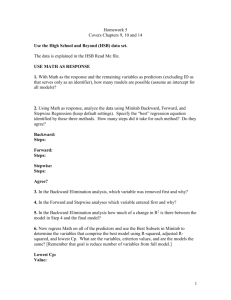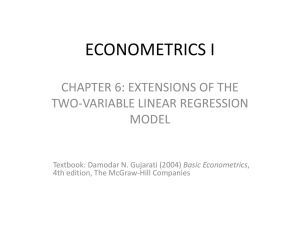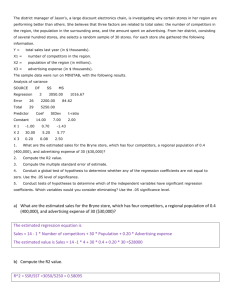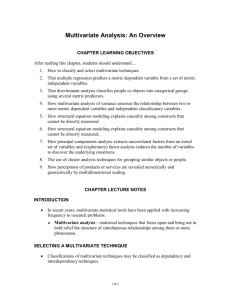Term
advertisement
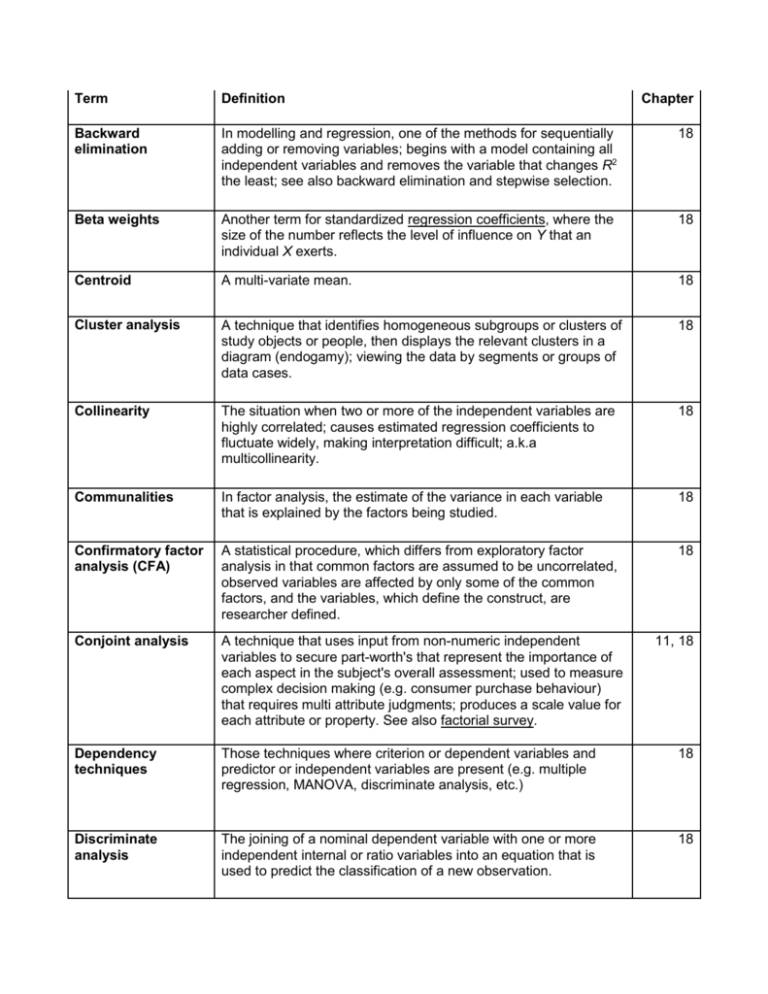
Term Definition Chapter Backward elimination In modelling and regression, one of the methods for sequentially adding or removing variables; begins with a model containing all independent variables and removes the variable that changes R2 the least; see also backward elimination and stepwise selection. 18 Beta weights Another term for standardized regression coefficients, where the size of the number reflects the level of influence on Y that an individual X exerts. 18 Centroid A multi-variate mean. 18 Cluster analysis A technique that identifies homogeneous subgroups or clusters of study objects or people, then displays the relevant clusters in a diagram (endogamy); viewing the data by segments or groups of data cases. 18 Collinearity The situation when two or more of the independent variables are highly correlated; causes estimated regression coefficients to fluctuate widely, making interpretation difficult; a.k.a multicollinearity. 18 Communalities In factor analysis, the estimate of the variance in each variable that is explained by the factors being studied. 18 Confirmatory factor analysis (CFA) A statistical procedure, which differs from exploratory factor analysis in that common factors are assumed to be uncorrelated, observed variables are affected by only some of the common factors, and the variables, which define the construct, are researcher defined. 18 Conjoint analysis A technique that uses input from non-numeric independent variables to secure part-worth's that represent the importance of each aspect in the subject's overall assessment; used to measure complex decision making (e.g. consumer purchase behaviour) that requires multi attribute judgments; produces a scale value for each attribute or property. See also factorial survey. Dependency techniques Those techniques where criterion or dependent variables and predictor or independent variables are present (e.g. multiple regression, MANOVA, discriminate analysis, etc.) 18 Discriminate analysis The joining of a nominal dependent variable with one or more independent internal or ratio variables into an equation that is used to predict the classification of a new observation. 18 11, 18 Dummy variable Nominal variable used in multiple regressions and coded 0, 1 as all other variables must be interval or ratio measures. Factor In experiments it denotes an independent variable (IV); these are divided into treatment levels for the experiment. 9, 18 Factor analysis Techniques for discovering patterns among the variables to determine if an underlying combination of the original variables (a factor) can summarize the original set. 18 Forward selection In modelling and regression, one of the methods for sequentially adding or removing variables; starts with the constant and adds variables that result in the largest R2 increase; see also backward elimination and stepwise selection. 18 Holdout sample A portion of the sample--usually 1/3 or 1/4--is set aside and only the remainder is used to compute the estimating equation. The equation is then used on the holdout data to calculate R2 for comparison. 18 Interdependency techniques Those techniques where criterion or dependent variables and predictor or independent variables are not present (e.g. factor analysis, cluster analysis, multidimensional scaling, etc.). 18 LISREL A technique (linear structural relationships) useful in explaining causality among constructs that cannot be directly measured, by analysing covariance structures. 18 Loadings In principal components analysis, the correlation coefficients between the factor and the variables. 18 Metric/non-metric measures Refers to statistical techniques using interval and ratio measures (metric) and ordinal and nominal measures (non-metric), 18 Multicollinearity The situation where some or all of the independent variables are highly correlated; a.k.a. collinearity 18 Multidimensional scaling (MSD) A scaling technique for objects or people where the instrument scale seeks to measure more than one attribute of the respondent or object; results are usually mapped; develops a geometric picture or map of the locations of some objects relative to others on various dimensions or properties; especially useful for difficultto-measure constructs. 18 11, 18 Multiple regression A descriptive tool used to (1) develop a self-weighting estimating equation by which to predict values for a dependent variable from the values of independent variables, (2) control confounding variables to better evaluate the contribution of other variables, or (3) test and explain a causal theory. 18 Multivariate analysis Those statistical techniques that focus upon and bring out in bold relief the structure of simultaneous relationships among three or more phenomena. 18 Multivariate analysis of variance (MANOVA) A technique that assesses the relationship between two or more dependent variables and classificatory variables or factors; frequently used to test differences among related samples. 18 Path analysis The use of regression to describe an entire structure of linkages that have been advanced by a causal theory. 18 Path diagram A diagram that presents predictive and associative relationships among constructs and indicators in a structural model. 18 Principal components analysis The most frequently used method of factor analysis, which transforms a set of variables into a new set of composite variables that are linear and not correlated with each other; see also factor analysis. 18 Rotation In principal components analysis, a technique used to secure less ambiguous relationships between factors and variables by performing a matrix analysis and thus aid in interpretation of the analysis. 18 Specification error A bias that overestimates the importance of the variables included in a structural model. 18 Standardized coefficients The X values re-stated in terms of their standard deviations (a measure of the amount that Y varies with each unit change of the associated X variable). 18 Stepwise selection In modelling and regression, the most popular method for sequentially adding or removing variables; combines forward and backward sequential methods. 18 Stress index An index used in multidimensional scaling that ranges from 1 (worst fit) to 0 (perfect fit). 18 Utility scores (partworths) Used in conjoint analysis and computed from a subject's rankings or ratings of a set of cards, with each card describing one possible configuration of combined concepts and constructs. 18 Vector A quantity that has direction and magnitude commonly represented by a directed line segment whose orientation in space represents the direction and length represents the magnitude. 18



